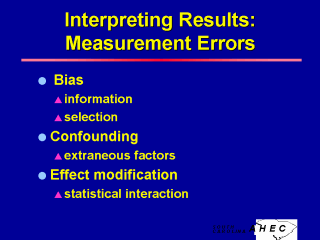| front |1 |2 |3 |4 |5 |6 |7 |8 |9 |10 |11 |12 |13 |14 |15 |16 |17 |18 |19 |20 |21 |22 |23 |24 |25 |review |
 |
Bias is the tendency of a measurement to deviate from the true value. Information bias derives from measuring the outcome or exposure such that information is more accurate or more complete in one group than another; this includes interviewer or observer bias, recall bias and reporting bias. Selection bias occurs because of differences between those who are not selected for a study or a group within a study; this includes ascertainment bias, detection bias, and response bias. Confounding can occur when a variable related to the condition under study is associated with, but not a consequence of, the exposure under investigation. While it is never possible to control all factors in an epidemiologic study, findings will be easier to interpret if extraneous factors are eliminated or made identical for cases and controls. Effect modification occurs when the magnitude of the association between one variable and another differs according to the level of a third variable. Detecting effect modification is an important aspect of data analysis. |